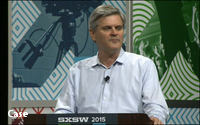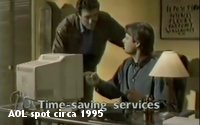 AUSTIN, TEXAS -- Online media pioneer Steve Case kicked off Day Two of the SWSW Interactive festival here with a talk surfing two meaningful waves of the Internet, and put attendees in a position to
catch the third one, just as it’s cresting.
AUSTIN, TEXAS -- Online media pioneer Steve Case kicked off Day Two of the SWSW Interactive festival here with a talk surfing two meaningful waves of the Internet, and put attendees in a position to
catch the third one, just as it’s cresting.
Case began with a history lesson for the attendees -- many of whom were not yet born when Case began applying to business schools in
1980 -- pitching them on his vision for how technology would revolutionize media and commerce.
“Well, every business school I applied to rejected me,” Case said, and
instead of going to graduate school he entered the field of marketing, doing a short stint at Procter & Gamble, followed by a job as director of pizza development at Pizza Hut.
But it wasn’t until he geeked out personally, buying his first computer -- a Kaypro -- in 1982, getting a modem, subscribing to an online service (Compuserv), and going through all the
hardships required of getting online then.
advertisement
advertisement
“It cost $10 an hour to be connected,” case said, dating himself and adding, “but I was hooked.”
A few pivots (Gamelink and Applelink) later, Case and fellow AOL founders officially launched America Online and began the process of making online media easier and more accessible to people
beyond the techies and early adopters that were its first customers.
Case showed two vintage AOL TV campaigns. The first spot from 20 years ago looked like a public school
educational film and explained the commerce, information and education promises of getting online in what now seems painfully rudimentary terms. The next spot, from 15 years ago, was more
super-charged, and began focusing on strategy partnerships with content suppliers to drive mass adoption. They both worked, because by 1992, AOL went public and the rest is, as they say, history.
But Case reminded the SXSW crowd -- many of whom also were not yet born -- that 1992 also was the year that Congress voted to approve the commercial use of the Internet.
“It was actually illegal for most people to connect to the Internet before 1992,” he said, noting that it was originally relegated to engineers, scientists and
educators.
Case described that period through 2000 as the “first wave of the Internet,” which was really about building its infrastructure and sorting out some rules of
the road for the information superhighway.
Its “second wave” -- the period from 2000 to present -- he characterized as a period of “building on top of” the
early Internet, in which businesses like Google (search), Facebook (social), YouTube (video) and Twitter (communications), as well as the app development marketplace, created new value and reasons for
people to use the Internet.
The second wave, he said, mainly disrupted two industries -- media and retail commerce. The next wave -- the one he implied is cresting right now -- will
begin to disrupt other fundamental industries, such as healthcare, education, transportation and food.
Case predicted the third wave will also see the rise of two of the core
elements of the first wave -- the role of strategic partnerships and the role of government -- but he also made some predictions on four significant trends that will drive it.
The
first, he said, was greater “access to capital” to fund even greater and more pervasive innovation on the backbone of the Internet. Specifically, he said the acceleration of venture
capital funding that began during the second wave would continue and would be followed by an acceleration of “crowdfunding” platforms that would give access to capital to more startups in
more places around the world.
Case noted that three states -- California, New York and Massachusetts -- accounted for 75% of venture funding last year. He said this is already
beginning among so-called “accredited investors” and that the Securities and Exchange Commission is poised to life barriers for average people to invest in startups via crowdfunding.
 The
second, big development of the third wave, he said, would be the “re-emergence of strategic partnerships.”
The
second, big development of the third wave, he said, would be the “re-emergence of strategic partnerships.”
The third would be the rise of “impact investing”
-- startups backed by investors more interested in the social impact of new businesses than in their profits.
The fourth, he said, is that “entrepreneurship will be going
regional and global” and that technology and new means of access to capital would spur startup innovation from regional outposts inside the U.S. and around the globe that would bring new kinds
of creativity and culture to the mix.
Case called the trend the “Rise of the Rest,” which is also the name of a series of road trips promoting the idea that he has
organized.
While he said he believes that Silicon Valley will remain the dominant market fueling capital-funded innovation, along with New York and Boston, the rise of the rest would
mean that new pockets will emerge as well.
Case noted that this is not new in the course of American industrial innovation, pointing out that “60 years ago, Detroit was Silicon
Valley,” meaning it was the economic center of technological innovation.
“One hundred to 125 years ago, it was Pittsburgh,” he continued, adding that 200 years ago
it was the agricultural heartland.
When those centers were the centers of American innovation, Case reminded the audience, “Silicon Valley was apple orchards.”